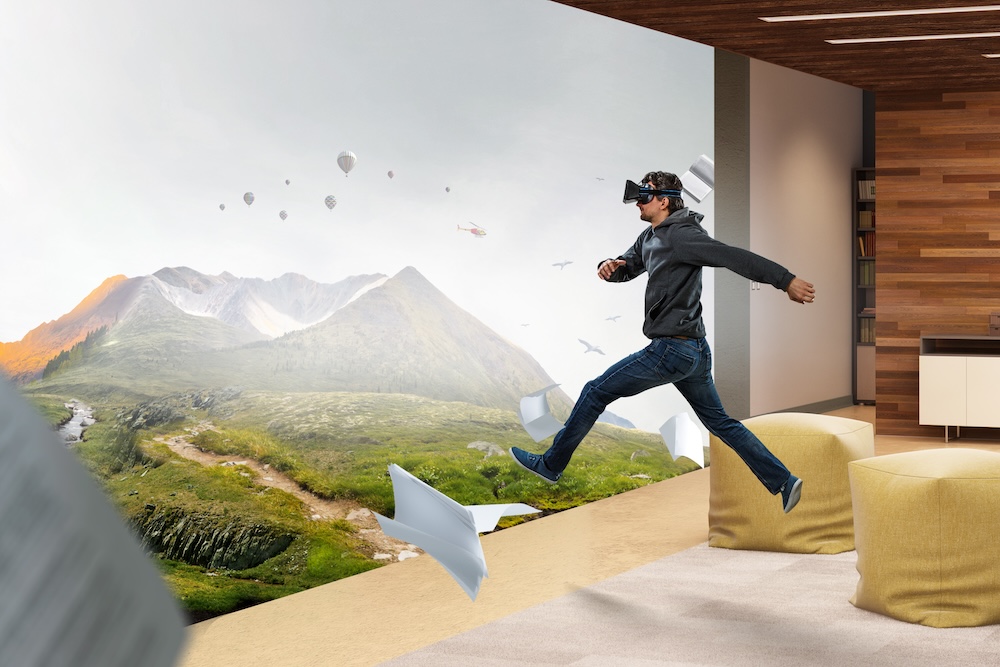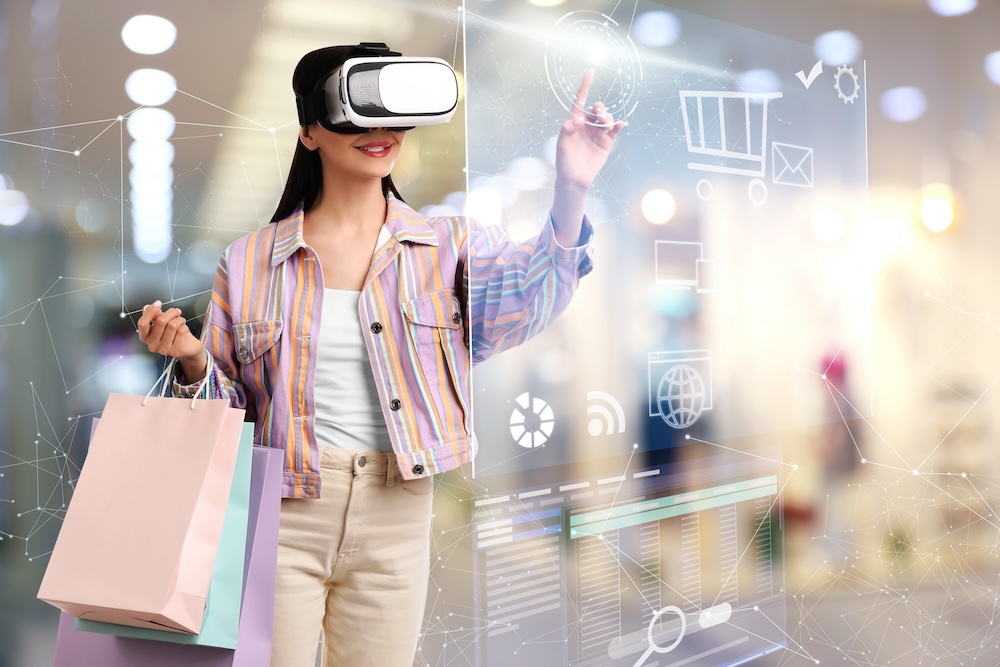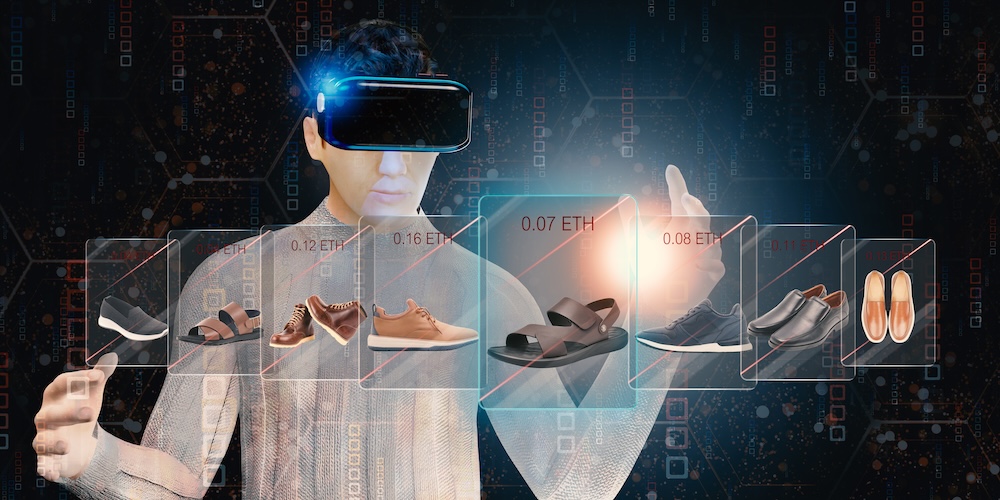Introduction
Augmented reality (AR) has evolved from a futuristic concept to a powerful tool that integrates digital information with the real world. It enhances the user’s perception by overlaying digital elements onto physical surroundings, creating an immersive and interactive experience. AR has gained significant traction in various industries, including gaming, healthcare, education, and marketing. Unlike virtual reality which creates an entirely artificial environment, AR enriches the existing environment by adding informative or entertaining digital content.

In modern marketing, AR is reshaping traditional advertising methods by providing consumers with engaging and personalized experiences. Brands are leveraging AR to create interactive campaigns that capture attention and drive consumer engagement. From virtual try-on experiences for fashion products to interactive product demonstrations, AR allows brands to showcase their offerings in innovative ways while also collecting valuable data on consumer behaviour. The ability of AR to bridge the physical and digital worlds enables marketers to reach audiences in more meaningful and memorable ways, ultimately leading to increased brand awareness and customer loyalty.
The importance of integrating AR into modern marketing strategies cannot be overstated. As consumers increasingly seek unique and immersive experiences, brands need to adapt their approaches to stand out in a crowded marketplace. By incorporating AR into their campaigns, marketers can deliver captivating experiences that resonate with audiences on a deeper level while differentiating themselves from competitors. Furthermore, the data collected through user interactions with AR can provide invaluable insights into consumer preferences and behaviors, enabling brands to tailor their offerings more effectively. In essence, Augmented Reality is not just a passing trend;
The Rise of AR in Marketing

Augmented reality (AR) has swiftly made its mark as a game-changer in the marketing industry. With its ability to overlay digital content onto the real world, AR has created new and innovative ways for brands to engage with consumers.
According to recent studies, the adoption of AR in marketing is on the rise. The global AR market size is projected to reach $198 billion by 2025, with marketing being one of the key sectors driving this growth. Moreover, research shows that 61% of consumers prefer stores that offer AR experiences, indicating a growing demand for interactive and immersive shopping encounters.
Numerous brands have reaped the benefits of integrating AR into their marketing campaigns. For instance, beauty giant Sephora implemented an AR “Virtual Artist” feature within its app, allowing users to try on different makeup products virtually. This not only enhanced user engagement but also led to a notable increase in conversions and customer satisfaction.
Another remarkable case is Burger King’s use of an AR campaign that turned customers’ physical surroundings into a portal where they could interact with a virtual car and earn discounts. This creative approach not only captured attention but also resulted in a significant boost in foot traffic and sales for participating locations.
These examples represent just a fraction of the successful AR campaigns that have resonated with consumers and delivered tangible results for brands across various industries.As consumer preferences continue to gravitate towards interactive and personalized experiences, the incorporation of augmented reality into marketing strategies has proven to be immensely impactful. Its ability to captivate audiences while offering practical value makes it an invaluable tool for forward-thinking marketers looking to stand out in today’s dynamic marketplace.
Enhancing Consumer Experience with AR
In today’s highly competitive marketplace, providing consumers with engaging and personalized experiences is paramount for brands looking to create lasting impressions. Augmented reality (AR) has emerged as a powerful tool for enhancing the consumer experience, offering interactive and immersive encounters that bridge the physical and digital worlds.

AR enables brands to revolutionize product demonstrations by bringing them to life in a dynamic and interactive manner. By overlaying digital elements onto physical products or spaces, AR allows consumers to engage with and explore products in captivating ways. This not only enhances understanding but also creates a memorable experience that drives increased interest and purchase intent.
One of the most compelling applications of AR in consumer experience is through virtual try-ons and immersive experiences. From trying on apparel and accessories to visualizing furniture in their homes, consumers can interact with products in a way that was previously impossible. The ability to see how products fit or look in real-life settings not only increases confidence in purchase decisions but also instils a sense of excitement and satisfaction.
In conclusion, the integration of AR into consumer experiences offers limitless potential for brands seeking to differentiate themselves and leave a lasting impact on their audience. By leveraging interactive product demonstrations, virtual try-ons, and immersive experiences, brands can elevate their engagement with consumers while delivering meaningful value that sets them apart from competitors.
AR’s Impact on Brand Engagement
As the marketing landscape continues to evolve, brands are constantly seeking innovative ways to capture and retain consumer attention. Augmented reality (AR) has emerged as a game-changing tool for elevating brand engagement, offering unique opportunities to build awareness, encourage interaction, and foster social sharing.
Building Brand Awareness with AR
AR provides brands with an unprecedented platform to showcase their products or services in captivating and memorable ways. By leveraging AR technology, brands can create interactive experiences that not only capture consumers’ interest but also leave a lasting impression. Whether it’s through immersive storytelling, entertaining visualizations, or interactive demonstrations, AR allows brands to engage with their audience on a deeper level, thus solidifying their presence in consumers’ minds.
Encouraging Social Sharing and Virality
AR experiences have the inherent ability to evoke excitement and curiosity among users, making them highly shareable across social media platforms. From AR-powered games and filters to interactive brand activations, the compelling nature of AR content often prompts users to share their experiences with friends and followers. This organic sharing not only amplifies brand reach but also cultivates a sense of community around the brand as users interact with and discuss their AR encounters.
Implementing AR in Marketing Strategies
As the demand for immersive and interactive experiences continues to grow, many marketers are turning to augmented reality (AR) as a way to captivate their audience. Integrating AR into marketing strategies can be a powerful tool for creating engaging campaigns and differentiating brands from competitors. However, this transition requires careful planning and consideration of potential challenges.
Steps to Integrate AR into Marketing
1. Define Objectives: Begin by clearly outlining the goals of implementing AR within your marketing strategy. Whether it’s enhancing customer engagement, increasing brand awareness, or driving sales, having specific objectives will guide your approach.
2. Understand Your Audience: Identify your target audience and determine how AR experiences can resonate with their preferences and behaviors. This understanding will shape the design and delivery of your AR content.
3. Choose the Right Technology: Assess available AR platforms and technologies that align with your campaign objectives. Consider factors such as compatibility with mobile devices, ease of use, and flexibility for content creation.
4. Create Compelling Experiences: Develop AR content that goes beyond novelty and provides genuine value to users. Whether it’s through interactive product demonstrations, virtual try-on experiences, or immersive storytelling, ensure that the experience is both captivating and relevant to your brand.
5. Promote Accessibility: Make your AR content easily accessible to users through various channels such as mobile apps, social media platforms, or in-store activations. Seamless access is crucial for maximizing user engagement.
Challenges and Considerations
While integrating AR into marketing strategies offers numerous benefits, several challenges should be taken into account:
1. Technical Complexity: Developing high-quality AR experiences may require specialized knowledge or external resources with expertise in AR development.
2. User Adoption: Not all consumers may be familiar with or open to interacting with AR content. Providing clear instructions and incentives can help encourage user adoption.
3. Cost Considerations: Implementing AR technology may involve initial investment in software development, hardware compatibility, and ongoing maintenance.
4. Measurement Metrics: Establishing reliable metrics to measure the effectiveness of AR campaigns is essential for evaluating ROI and optimizing future initiatives.
Despite these considerations, the potential rewards of integrating AR into marketing strategies are significant – from heightened consumer engagement to increased brand visibility in an increasingly competitive market landscape.
Exploring Ethical Implications of Augmented Reality in Advertising
As augmented reality (AR) continues to evolve, its application in advertising raises important ethical considerations. The ability to seamlessly blend digital content with the physical world introduces questions about truthfulness, transparency, and user manipulation. Marketers need to carefully consider how AR experiences may impact consumer trust and perception.
AR advertising has the potential to create immersive and engaging experiences for consumers. However, marketers must navigate the fine line between enhancing user experience and crossing ethical boundaries. Ensuring that AR content is not deceptive or misleading is crucial in maintaining ethical integrity.
To address these implications, industry professionals should engage in ongoing discussions and self-regulation efforts. Collaborating with regulatory bodies and consumer advocacy groups can help establish best practices that prioritize ethical standards while harnessing the innovative potential of AR technology.
Ensuring User Privacy and Consent in AR Experiences
The use of augmented reality in marketing requires heightened attention to user privacy and consent. As AR technology collects real-time data from users’ environments, it becomes imperative for marketers to implement robust privacy measures and obtain explicit consent for data collection and usage.
Respecting user privacy involves transparently communicating what data is being collected, how it will be used, and providing individuals with clear opt-in/opt-out mechanisms. Marketers must prioritize data security by adhering to established privacy regulations such as GDPR or CCPA, ensuring that personal information is handled responsibly within AR experiences.
Incorporating a layered approach to privacy within AR applications can empower users to make informed decisions about their data while fostering trust in the brand. Upholding strict data protection principles not only aligns with ethical values but also safeguards against potential reputational risks associated with mishandling consumer information.
Strategies for Responsible and Transparent Use of AR in Marketing Campaigns
Building responsible and transparent AR marketing campaigns hinges on clear communication, honesty, and empowerment of the consumer. Leveraging AR for advertising demands a commitment to authenticity and accuracy while delivering value-driven experiences for users.
Marketers should incorporate educational elements within AR campaigns, enlightening consumers about how the technology operates, what data may be collected, and highlighting the benefits of participation. By promoting transparency throughout every stage of engagement, brands can cultivate a sense of goodwill among their audience.
Employing interactive features enabling users to control their level of engagement while respecting their preferences is integral. Giving consumers agency over their experience reaffirms a commitment to ethical use of AR technology in marketing initiatives.
Furthermore, embracing feedback mechanisms allows businesses to continually improve their approaches based on user insights, demonstrating accountability and a dedication to ethical alignment within marketing strategies utilizing augmented reality.
Measuring ROI in AR Marketing Campaigns
Augmented reality (AR) has emerged as a powerful tool for marketers, offering innovative ways to engage audiences and drive brand objectives. However, evaluating the return on investment (ROI) of AR marketing campaigns presents unique challenges. In this article, we delve into the intricacies of measuring ROI in AR marketing, exploring strategies to assess effectiveness, analyze key performance indicators (KPIs), and examine case studies that exemplify successful ROI measurement in AR campaigns.
Evaluating the Effectiveness of AR in Achieving Marketing Goals
The first step in measuring the ROI of an AR marketing campaign is to clearly define its objectives. Whether the goal is to increase brand awareness, drive sales, or enhance customer engagement, establishing specific and measurable targets will facilitate the evaluation process. By aligning the use of AR with predefined marketing goals, organizations can better assess its impact through quantitative and qualitative analysis.
Effectiveness can be measured through various lenses, such as user engagement metrics, impact on purchase decisions, or influence on brand perception. For instance, tracking user interaction within an AR experience can provide insights into engagement levels and overall interest in the campaign. Additionally, surveying participants about their purchasing behavior or brand sentiment post-AR engagement can offer valuable qualitative data to gauge effectiveness.
Analyzing Key Performance Indicators (KPIs) for AR Campaigns
Identifying relevant KPIs is instrumental in evaluating the success of AR marketing initiatives. While traditional KPIs like conversion rates and click-through rates remain pertinent, AR-specific metrics are vital for comprehensive assessment.
Metrics such as dwell time within AR experiences, interactions per user session, social media shares generated by AR content, and subsequent foot traffic or web traffic driven by AR campaigns contribute to a holistic view of performance. These indicators reflect not only user engagement but also potential impact on business outcomes.
Moreover, leveraging technology to track behavioral data within AR environments enables marketers to gather real-time insights into user preferences and behaviors. Understanding how users navigate through augmented experiences provides invaluable data for refining future campaigns and optimizing ROI.
Case Studies on Measuring Return on Investment in AR Marketing
To understand the practical application of measuring ROI in AR marketing campaigns, it’s instructive to examine successful case studies that have demonstrated tangible results.
One notable example is a furniture retailer that integrated AR technology into its mobile app to allow customers to visualize how products would appear in their homes. By analyzing post-implementation sales data alongside usage analytics from the app’s AR feature, the retailer observed a significant increase in both online and offline purchases related to products viewed through the augmented reality function. This clear correlation between heightened consumer engagement via AR and actual sales uplift illustrated a strong ROI for the company’s investment in this technology.
Another compelling case study involves a cosmetic brand that utilized AR filters and virtual try-on experiences across social media platforms. Through careful tracking of user interactions with these digital assets and subsequent purchase behavior, the brand was able to attribute a substantial portion of its revenue growth directly to the influence of augmented reality-based marketing efforts.
In both instances, tracking relevant KPIs specific to their respective objectives enabled these companies to ascertain meaningful ROI from their deployment of augmented reality within their marketing strategies.
The Future of AR in Marketing
As augmented reality (AR) continues to evolve, its future in marketing presents an array of exciting possibilities. With ongoing advancements in AR technology, the marketing landscape is poised for transformation, offering new and innovative ways for brands to engage with consumers.
Predictions for AR Technology Advancements
1. Enhanced Personalization: Future AR advancements are expected to enable more personalized experiences, allowing brands to tailor AR content based on individual consumer preferences and behaviors.
2. Integration with AI: The convergence of AR and artificial intelligence (AI) is anticipated to result in more intelligent and adaptive AR experiences, further blurring the lines between the digital and physical worlds.
3. Wearable AR Devices: The development of wearable AR devices, such as smart glasses or advanced headsets, could open up new opportunities for marketers to deliver seamless and immersive AR interactions.
4. Spatial Computing: Advancements in spatial computing technologies will likely lead to more sophisticated spatial mapping and object recognition capabilities within AR environments.
Potential New Avenues for Marketing with AR
1. Augmented Commerce: The integration of AR into e-commerce platforms could revolutionize the way consumers shop online by offering immersive virtual try-on experiences for products ranging from apparel to home furnishings.

2. Location-Based Experiences: As AR technology advances, location-based marketing initiatives may leverage geospatial features to deliver contextualized AR content based on a user’s physical location and surroundings.
3. Interactive Storytelling: Future developments in AR are likely to facilitate richer narrative experiences, enabling brands to craft interactive storytelling campaigns that bridge the gap between virtual narratives and real-world environments.
4. Social Augmented Reality: With the rise of social media platforms embracing AR features, marketers can anticipate utilizing shared augmented experiences as a means to foster community engagement and social sharing.
Last but Not Least
The future of AR in marketing holds great promise, providing marketers with an evolving toolkit to create deeply engaging experiences that resonate with consumers on a profound level while pushing the boundaries of creativity and innovation in brand-consumer interactions. As technology continues to advance rapidly, staying abreast of these developments will be key for marketers aspiring to harness the full potential of augmented reality in their strategies.
In conclusion, the potential of augmented reality in marketing is vast and transformative. From enriching consumer experiences to driving brand engagement and paving the way for innovative marketing strategies, AR offers an array of benefits for marketers.
As the future of marketing continues to evolve, there’s never been a more exciting time for marketers to explore the potential that AR holds. Embracing AR technology can empower marketers to stay ahead of the curve and connect with consumers in new, innovative ways. By integrating AR into their marketing strategies, businesses can differentiate themselves in a crowded marketplace, offering unique and immersive experiences that leave a lasting impression on their audience.
In this era of digital transformation, we encourage marketers to explore the opportunities presented by augmented reality and consider how it can be seamlessly integrated into their strategies to elevate brand engagement and drive meaningful connections with consumers. The time is ripe to embrace AR as a powerful tool for transforming the future of marketing.











